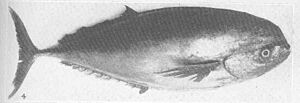Louvar facts for kids
Quick facts for kids Louvar |
|
|---|---|
 |
|
| Conservation status | |
| Scientific classification | |
| Synonyms | |
|
The louvar (Luvarus imperialis) is a unique type of ray-finned fish that lives in the ocean. It is the only living species in its group, called Luvarus, and its family, Luvaridae. This fish is related to surgeonfish and is the only one in its group that lives in the open ocean, not near the bottom. Young louvars have small spines near their tail, much like surgeonfish. However, these spines disappear as the fish grows into an adult.
Contents
About the Louvar's Name
The louvar was first officially described in 1810 by a French scientist named Constantine Samuel Rafinesque. He found it near Sicily, an island in Italy. He named it Luvarus imperialis.
Why is it Called "Louvar Imperialis"?
The name Luvarus imperialis comes from the Sicilian name for this fish, Luvari imperiali. It was given this name because it looks a bit like another fish called the common pandora (Pagellus erythrinus), which is known as luvari in Sicily. The word imperialis means "imperial" or "majestic." This might refer to how good the fish tastes.
What Does the Louvar Look Like?
The louvar has a strong, oval-shaped body. It gets thinner towards its tail. It has a small mouth and eyes that are set low on its head, behind its mouth. Its forehead is large and bulges out.
Fins and Skin
The fins on its back and belly are long but not very tall. They do not have any sharp spines. The tail fin is large and curved inward. The thin part of the body before the tail has one or two bumps near the tail fin. Its belly fins are tiny, but its chest fins are long and pointed. The louvar's skin feels rough because it has very small spines all over it.
Colors and Size
The fish is usually a shiny bluish-grey color, sometimes with hints of pink or orange. Its back fin and tail fin are reddish. Louvars can grow quite large. The biggest ever recorded was about 200 centimeters (about 6.5 feet) long. However, they are more commonly around 152 centimeters (about 5 feet) long. They can weigh up to 150 kilograms (about 330 pounds).
How Juveniles Change
Young louvars look a bit different from adults. Their back and belly fins are longer, and they start closer to the head. Young ones also have long belly fins and teeth in their jaws. As they grow into adults, they lose these features.
Where Do Louvars Live?
Louvars are found in oceans all over the world, in both warm (tropical) and cooler (temperate) waters. They are common in the Indo-Pacific region, which includes the Indian and Pacific Oceans. In the Atlantic Ocean, they are found in specific areas, more often in the eastern part than the western. They have also been seen in the Mediterranean Sea.
Their Ocean Home
This fish lives in the open ocean, either near the surface or in deeper waters. They can be found as deep as 200 meters (about 650 feet) below the surface.
Louvar Life and Habits
Louvars are usually found alone. They are carnivores, which means they eat other animals. Their diet mainly consists of soft-bodied zooplankton, like jellyfish and comb jellies.
Reproduction
Female louvars lay their eggs from late spring through the summer months. Each female can lay millions of tiny eggs. These eggs float freely in the open ocean.
Louvars and Fishing
Louvars are very rare fish. People do not usually try to catch them on purpose. Instead, they are often caught by accident when fishermen are trying to catch other types of fish. This is called bycatch.
Valued for Eating
Even though they are rare, louvars are considered a very good fish to eat. For example, in the United States, they are hardly ever seen in fish markets because they are not targeted by fishing boats. Sometimes, fish are removed from markets if they have many parasites.
Images for kids



